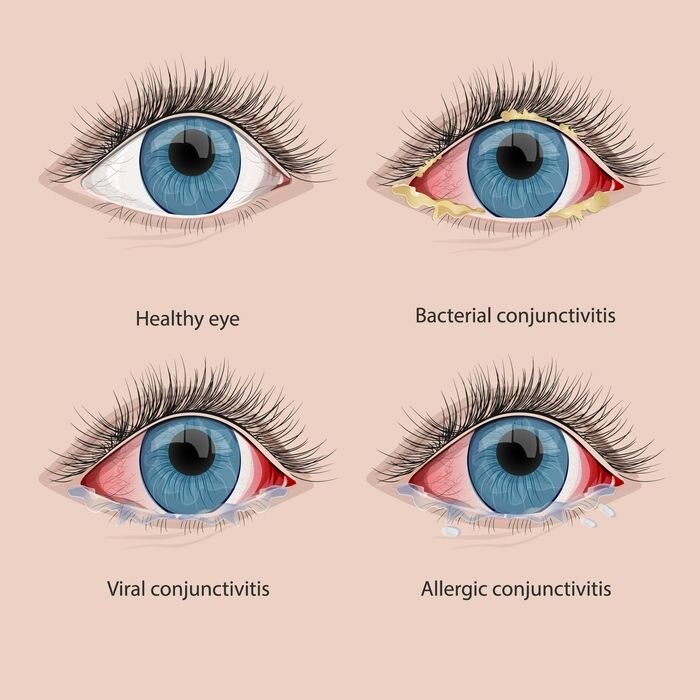Pink Eye
What is Conjunctivitis?
Conjunctivitis, more commonly known as “pink eye,” occurs when the thin layer of tissue lining your eyelid and the front of your eye becomes infected or inflamed. Although conjunctivitis is typically not serious, it can be very uncomfortable, and it is highly contagious. Additionally, if left untreated, the condition could eventually affect your vision. For these reasons, it is important to contact your eye doctor as soon as possible. Treatments may include oral medications, antibiotic eye drops, or ointments.
COMMON SYMPTOMS OF CONJUNCTIVITIS
Discomfort
One common sign of conjunctivitis is itchy, burning, or watery eyes. You may also experience a gritty sensation, as if there is something stuck in your eye. Generally, patients with this condition are also extra sensitive to light.
Discharge
Often, inflammation is also associated with yellow, green, or white discharge. The type of discharge is typically related to the cause of the conjunctivitis.
Discoloration
The most well-known symptom of conjunctivitis is red discoloration of the white part of the eye. For this reason, conjunctivitis is often referred to as pink eye.
Close Quarters and Contact Lenses INCREASE THE RISK FOR CONJUNCTIVITIS
Some forms of conjunctivitis are highly contagious and spread quickly among individuals who are in close contact with each other. For this reason, pink eye is a common concern for school-age children.
However, individuals who wear contact lenses or have seasonal allergies are also likely to develop conjunctivitis. Since the condition is caused by irritation of the eye's outermost layer of tissue, known as the conjunctiva, any foreign bodies, such as hard contact lenses, cigarette smoke, or pollen can lead to conjunctivitis.
Allergies, Bacteria, and Viruses CAN ALL CAUSE CONJUNCTIVITIS
Allergic Conjunctivitis
Caused by eye irritants, allergic conjunctivitis can develop due to pollen, dust, or animal dander. It can also stem from exposure to substances, such as cigarette smoke, car fumes, or pool chlorine. This type is not contagious.
Bacterial Conjunctivitis
The bacterial form of conjunctivitis is most often caused by bacteria from your own hands or respiratory system. Physical contact with others, poor hygiene, and contaminated eye makeup can all cause bacterial conjunctivitis.
Viral Conjunctivitis
Most commonly caused by the same virus as the common cold, viral conjunctivitis is very contagious. You can be exposed to this form of conjunctivitis when other infected individuals cough or sneeze near you.
Symptoms
During your appointment, your doctor will ask about your symptoms and your medical history and then perform an eye exam. In some cases, they will take a sample of any liquid draining from your eye to analyze in the lab.
It can be difficult to determine the exact cause of conjunctivitis, since the symptoms are so similar. However, there are some differences which your doctor can use to determine the optimal treatment option for you.
Allergic Conjunctivitis
Tends to occur seasonally when pollen counts are high
Accompanied by intense itchiness in the eyes
Viral Conjunctivitis
Typically accompanies a cold or respiratory tract infection
Eye discharge is watery, rather than thick
Bacterial Conjunctivitis
Typically occurs at the same time as an ear infection or shortly after birth
Eye discharge is thick, rather than watery
Prevention
Practice Good Hygiene
One of the best ways to avoid developing conjunctivitis is hygiene. Wash your hands frequently, especially after contact with someone who is ill, avoid sharing eye makeup, and try not to touch your eyes.
Keep Contacts Clean
Make sure you are throwing away disposable contact lenses regularly and cleaning extended wear lenses properly. Ill-fitting or dirty contact lenses can cause conjunctivitis.
Limit Irritants
Dirt, dust, pollen, and other irritants can all cause inflammation in your eye. By minimizing your contact with irritating substances, you can protect your eyes against allergic conjunctivitis.
Treatment
Allergic Conjunctivitis
The first step is to eliminate contact with the irritant, if possible. Cold compresses and eye drops can help relieve the discomfort. In severe cases, anti-inflammatory medication, antihistamines, or topical steroids may be used.
Bacterial Conjunctivitis
Antibiotic eye drops or ointments are typically effective for bacterial conjunctivitis. You may see an improvement after only three or four days, but it is important to take the full course of antibiotics.
Viral Conjunctivitis
Like a common cold, viral conjunctivitis must simply run its course. You can relieve symptoms with cold compresses and eye drops. In some severe cases, your doctor may prescribe topical steroids to reduce discomfort.
Schedule an Appointment WITH YOUR DOCTOR
In mild forms, pink eye typically clears up within two to three weeks, often without any treatment. While severe forms of conjunctivitis can become serious, your doctor can help you find the right treatment plan to protect your sight against issues. If you have noticed signs of pink eye in yourself or your child, contact a doctor right away to schedule an appointment.



